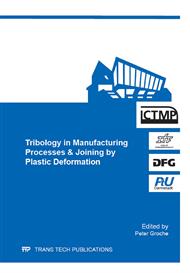p.425
p.435
p.445
p.453
p.461
p.471
p.481
p.489
p.500
Mechanism of Forming Joining on Backward Extrusion Forged Bonding Process
Abstract:
A backward extrusion forged bonding using low carbon steel and pure aluminum is conducted. The bonding strength between the materials is evaluated by a micro tensile test that is cut out at the bonding boundary. The maximum bonding strength is larger than that of the aluminum. In addition, the metallurgical mechanism of the joining of the backward extrusion forged bonding is investigated by means of a scanning transmission electron microscope (STEM). An intermetallic compound (IMC) layer is produced at the boundary with a thickness of about 3 nm. The process is applied for bonding between aluminum-nickel and between aluminum-copper. The bonding strength between the materials was evaluated by using a micro tensile test and the maximum bonding strength is shown. Fractured surfaces of the tensile specimens are observed by scanning electron microscope (SEM) and relationship between bonding strength and position on the boundary is discussed.
Info:
Periodical:
Pages:
461-470
Citation:
Online since:
June 2014
Authors:
Keywords:
Price:
Сopyright:
© 2014 Trans Tech Publications Ltd. All Rights Reserved
Share:
Citation:


